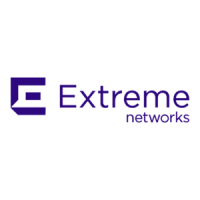EPICenter Features
EPICenter Concepts and Solutions Guide
15
● Monitor wireless Access Points and wireless clients. Through EPICenter’s dynamic reports you can
monitor the status of the Altitude 300 APs connected to your network and monitor wireless client
activity connected through those APs. You can also detect rogue APs connected to the network, and
add them to a “safe” list, or disable their access if necessary.
● Support for third-party devices. Any device running a MIB-2 compatible SNMP agent can be
discovered by the EPICenter Inventory Manager and monitored at a basic level. These devices can
appear on a topology map, with basic status and alarm handling based on MIB-2 functionality. Based
on EPICenter’s Third Party Integration Framework, selected appliances from Extreme Networks
partners can be integrated into EPICenter in a robust fashion that allows reporting, the use of Telnet
macros, alarm management, and monitoring with graphical front and back panel views in the
Inventory Manager.
● Manage large numbers of devices. The EPICenter Gold Upgrade enables the EPICenter server to
manage up to 2000 devices with a single installation of the EPICenter software. For even larger
networks you can split the management task among several EPICenter servers in a distributed server
mode that lets you monitor the status of those servers from a single client.
● Policy-based Management. As part of the EPICenter Advanced Upgrade (an optional, separately-
licensed component of the EPICenter software) the Policy manager lets you work with high-level
policy components (users, desktop systems, groups of users, devices, or applications) in defining
network policies used to protect and guarantee delivery of mission-critical traffic. The policy system
translates these into the specific information needed for QoS configuration of network devices. It also
detects overlaps and conflicts in policies, with precedence rules for resolving conflicting QoS rules.
The EPICenter features are described in more detail in the following sections. The rest of this manual
describes how to best use these features to manage various aspects of your network. For detailed
instructions on using specific features of EPICenter see the context-sensitive online Help available from
the Help menu at the top of every feature, as well as via Help buttons throughout the user interface of
the product. The EPICenter Reference Guide also provides a detailed description of the functionality of
each EPICenter feature.
Inventory Management
EPICenter’s Inventory Manager feature keeps a database of all the devices managed by the EPICenter
software. Any EPICenter user with read-only access to this feature can view status information about
the switches currently known to the EPICenter database.
The EPICenter Inventory Management provides a discovery function to discover the components of
your network. Users with the appropriate access (roles with read/write access) can use this feature to
discover Extreme devices as well as any third-party devices running a MIB-2 compatible SNMP agent.
Devices may be discovered by specific IP address or within a range of IP addresses. Third-party devices
that support SNMP version 3 (SNMPv3) are discovered as SNMP version 1 (SNMPv1) and are added to
the EPICenter database as SNMPv1 devices.
Network devices can also be added to the EPICenter database manually, using the Inventory Manager
Add function. Once a network device is known to the EPICenter database, you can assign it to a specific
device group, and configure it using the VLAN Manager, the Configuration Manager, Telnet macros, or
the embedded Device Manager (ExtremeWare Vista for Extreme devices). The Inventory Manger also
allows you to set a device to offline status so that EPICenter will not poll and can ignore traps when a
device is scheduled for maintenance.
EPICenter also provides a command-line utility that lets you create device groups and import large
numbers of devices into the inventory database through scripts, to streamline the process of adding and

